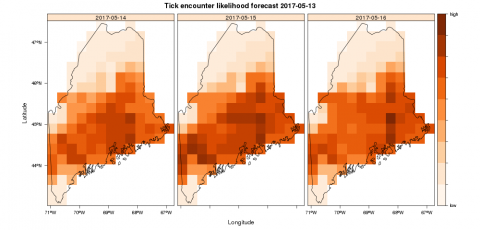"Tickcast" predicts likelihood of tick activity
Monday, May 22nd 2017

Going outside? Check the “Tickcast.”
The warmer weather is here, which means that we need to be extra careful about protecting ourselves against ticks and the diseases they carry, including Lyme. There were 1,473 cases of Lyme disease reported in Maine in 2016. Other tick-borne infections in the Maine include anaplasmosis (372 cases in 2016) and babesiosis (82 cases).
While Lyme disease is considered treatable, the easiest way to avoid it is prevention. The advice we hear the most is to be careful in tick infested areas (such as leaf mulch and long grass); wear protective clothing; use an EPA approved repellant; and perform daily tick checks.
Now you can add one more: check the Tickcast.
What is that you ask? It’s a daily predictor of the possibility of deer tick encounters in different regions organized by Nicholas Record, PhD., a senior research scientist at the Bigelow Laboratory for Ocean Sciences in East Boothbay. Record gathered data on ticks submitted to state public health officials over the years (over 20,000 reports), and developed a program that cross checked locations with historical weather information such as temperature, humidify, vegetation and snow cover. He analyzed it looking for trends and then created a formula that enables him to predict, based on weather forecasts, when ticks are likely to be most active and where.
He has collaborated on the project with Chuck Lubelczyk, a vector ecologist at the Maine Medical Center Research Institute’s “tick lab.”
The site can be found at http://seascapemodeling.org/tickcast.html. It’s updated regularly to include tick predictions for three days, and includes historical forecasts. A visitor to the site will find a map of New England overlaid with various shades of orange. Red denotes the highest likelihood of a tick encounter; the lighter the shade on down to pale pink, the less the likelihood of ticks.
These days the whole region is looking pretty red, which is sort of the point, according to Record, who wants to raise awareness of the need to be on the look out for ticks.
The mapping and forecasting project are a work in progress, he said. “We do still need to do some fine tuning,” he said. “But I wanted to have it out while we’re developing it to keep people aware of the tick problem and the need to check themselves for ticks.”
You can’t zoom in to specific towns to see more detail, for example. The hope is to add that and other refinements down the road. Record has not assigned specific numbers to the chart’s predictions because the likelihood of encountering a tick in a specific region depends on what a person is doing, whether they are out hiking in the woods or sitting in their yard.
Record works in the field of marine science, but he loves data. And when he kept on finding ticks on his children he was inspired to do his part in the fight against Lyme’s. In an effort to keep his forecast accurate, Record has set up a place where people can report ticks: report.bigelow.org/tick/.
“Over the summer, we’ll start incorporating those sightings into the forecast,” he said.
In addition to ticks, Record also keeps track of jellyfish and whale sightings. “If you see jellyfish, we’re interesting in knowing where and when, how many, and what kind you saw,” he said. You can email him at jellyfish@bigelow.org or enter the information online at jellyfish.bigelow.org.
If you are bitten by a tick, or spend a lot of time outdoors, watch for symptoms for up to 30 days, and call your healthcare provider if symptoms develop. The most common symptom of Lyme disease is a skin lesion, known as the “bull’s-eye” rash. This usually appears in 3-30 days after the tick bite. Other symptoms include fevers, headaches, and joint or muscle pain. Maine CDC has Lyme disease information at http://www.maine.gov/lyme.University of Maine Cooperative Extension Tick ID Lab submission instructions can be found at http://extension.umaine.edu/ipm/tickid/














